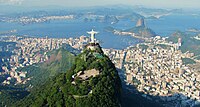
Photo from wikipedia
Epidemiological criteria are used to determine when a disease is rare. Although the rates vary, studies commonly adopt a threshold of 65 cases per 100,000 inhabitants to define any single… Click to show full abstract
Epidemiological criteria are used to determine when a disease is rare. Although the rates vary, studies commonly adopt a threshold of 65 cases per 100,000 inhabitants to define any single rare disease. However, when taken all together, rare diseases affect an estimated 6 to 8% of the population, according to a European study 1,2,3,4. The expression “rare disease” attributes a positive dynamism to the fact that each group of persons living with a given disease varies greatly, with the rate for a single disease considered low from the epidemiological perspective. When grouped under the heading “rare”, these diseases become more visible epidemiologically. This calls attention to the effort to acknowledge the presence of persons living with rare diseases in Brazil, their organization in associations, and their movements as qualified interest groups. This article focuses not on the distribution of rare diseases in the population, but on the agency of persons organized as interest groups, with mixed interactions 5,6, convening in public places, organizing agendas to occupy the streets 7, academic settings 8,9,10,11, and the legislative and judiciary branches. The historical background for Brazil’s National Policy for Persons with Rare Diseases in the Brazilian Unified National Health System (SUS), launched in 2014 12, included a public manifesto by various associations in 2011 13 and the National Policy for Comprehensive Care in Clinical Genetics in 2009 14. The most recent spinoff, in 2016, was the Ministry of Health’s accreditation of seven reference services in the Distrito Federal, Rio de Janeiro, Porto Alegre (Rio Grande do Sul State), Curitiba (Paraná State), Anápolis (Goiás State), Recife (Pernambuco State), and Santo André (São Paulo State) 15. The rare disease associations’ advocacy merits analysis in light of the social arenas model reviewed by Celina Souza 16. According to the above-mentioned author, “In order for a given circumstance or event to become a problem, people need to be convinced that something needs to be done” 16 (p. 32). Policymakers and decisionmakers are encouraged to either ignore or take interest in the problem, in a dynamic relationship with the community of experts. This community includes not only professionals and researchers, but also those with the authority of personal experience, like families. In the case of the needs of persons living with rare diseases, this community consists not only of the individuals themselves and their family members – especially when the person with the rare disease is a child or adolescent – but also the persons that join efforts and resources to see their demands met from a future perspective, that is, “They’re crucial for an idea’s survival and success and to include the problem on the public agenda” 16 (p. 32). When rarity is an asset: political activism for the rights of persons with rare diseases in the Brazilian Unified National Health System
Journal Title: Cadernos de saude publica
Year Published: 2018
Link to full text (if available)
Share on Social Media: Sign Up to like & get
recommendations!